Article written and published by Brandon Rael - Rethink Retail leader
Product returns are a core part of the customer journey. The digital and physical shopping experience boundaries are a thing of the past. Customers are seamlessly navigating from discovery to consideration and the transaction process and have the product fulfilled in the most convenient way, including BOPIS, curbside pickup, and shipping to the home. The overall ecommerce sales were $1.1 trillion in 2023, an increase of 7.6% (+1.2%) from 2022's 14.7% of total sales, which directly translates to customers returning products at an unprecedented rate.
State of product returns – challenges and opportunities
Historically, retailers have always focused on mitigating product returns, considering them a challenge or issue. With total retail returns coming in at $743B in 2023 at an overall return rate of 14.5% and online return rates at 17.6%, or $247B, there is a significant opportunity for retailers to optimize and learn from the returns processes. However, the perception of returns as a complete loss is misguided.
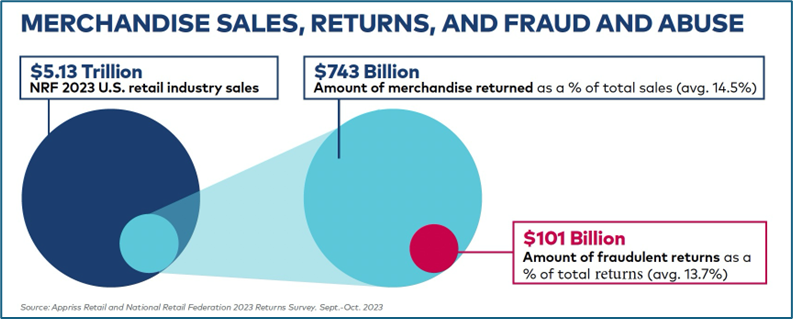
NRF 2023 Returns Survey
Shifting the mindset can change the negative narrative of returns to present opportunities not only to decrease return rates but also to drive profitable and sustainable growth across many of the core retail operational areas, including:
- Ecommerce and marketing optimization
- Merchandising
- Product Development
- Assortment Planning
- Return Channel Optimization (Stores, Third Party, and Vendor Management)
Changing the narrative starts with the "why"
To provide a more seamless shopping experience, retailers have focused on improving the overall returns processes, including using QR codes, providing flexible shipping options, and, in most cases, at no cost to the customer. However, rather than just investing in capabilities to make the returns process more efficient and flexible, there is a unique opportunity to leverage AI capabilities to examine the root causes and customer feedback optimally. Incisiv completed a recent study that found that a staggering 73% of returns are classified as "controllable." Meaning that there are strategic and prescriptive approaches retailers can leverage to change the go-forward narrative, including resolving:
- Faulty product design
- Quality issues
- Delivery damages
- Service and stock issues
- Size/fit presentation
As we witnessed at the latest NRF 2024 Big Show, AI capabilities are no longer in the hype cycle. They are embedded within many solution capabilities, including the retail product returns processes. Leveraging AI insights has quickly become intuitive and the industry standard to keep up with rapidly changing consumer behaviors. Additionally, a study commissioned by Microsoft and conducted by IDC shared that retailers average a return on investment of $3.45 for every $1 they invest in AI.

Getty Images
By integrating advanced AI-powered capabilities, Newmine has quickly emerged as the leading retail industry solution provider in helping to solve the returns issue. Their Chief Returns Officer® intelligence platform helps retailers get ahead of the curve by providing a holistic perspective and drill-down capabilities to understand the "why" - the root causes of the returns. However, the key differentiator of their industry-leading solution, built on Microsoft Azure capabilities, is that it helps to enhance revenue streams, including the following enterprise-wide advantages:
- Determining why products are being returned
- Providing early, in-season visibility of returns
- Empowering retail teams with proactive opportunities for improvement
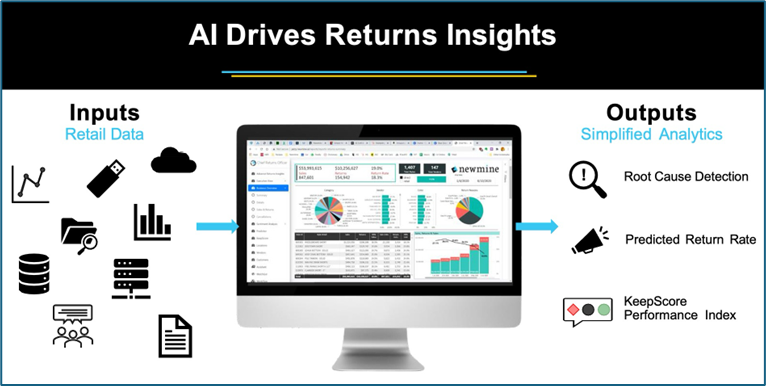
Newmine Chief Returns Officer® AI Platform
Once Newmine's comprehensive AI-powered returns solution is operationalized, the impact of applied AI returns reduction strategies has a direct effect on a retailer business by unlocking the following business value:
- 4% Increase Revenue: By improving net sales
- 100 bps Higher Margin: Through less returns processing
- 20% Fewer Returns: With actionable insights
With a strategic approach, returns insights lead to profitable growth across the retail value chain
Ecommerce and marketing optimization
The valuable insights provided by Newmine's KeepScore Performance Index drive strategic decision-making in-season to optimize online assortments and sell more products that customers love. Retailers can analyze customer return behaviors using the RFM (recency, frequency, monetary) methodologies. With AI-powered insights, customers can be segmented into more finite clusters and drive marketing personalization strategies to increase the overall customer lifetime value.
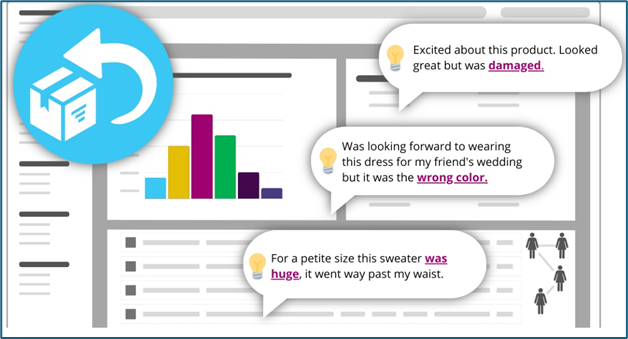
Newmine Chief Returns Officer
In the retail industry, retaining loyal customers is critical, especially as articulated by the research done by Frederick Reichheld of Bain & Company, which details that maintaining customer retention rates by 5% potentially increases profits between 25% and 95%. With all the available recency returns data, retailers have an opportunity to make swift strategic changes to their ecommerce platforms in-season that will have a direct impact on revenue growth and profitability, including:
- Updating web content and images
- Fixing product specifications
- Personalizing marketing and promotions strategies
- Enhancing marketing strategies with existing and new customers
Merchandising, Product Development, and Assortment Planning
Leveraging the power of Newmine's capabilities and returns insights, retailers have a critical opportunity to incorporate returns into the whole product development, merchandising, and assortment planning life cycle. By transforming the mindset of viewing returns as a cost function, the product functions can change the narrative to growth strategies throughout the go-to-market processes. Optimizing these processes can simultaneously reduce operating costs, drive profitability, and improve customer loyalty with in-season management strategies.
Merchandising:
Leveraging returns data from previous seasons and recency insights can inform and shift the breadth and depth of the replenishment cycle. Retailers can make far more informed decisions by analyzing the SKU and category performance along with the total economic impact, including returns processing costs. Newmine's returns insights provide more KPIs to enable flexible and actionable changes in season, to react to changing consumer behaviors, and to invest in profitable categories and SKUs.
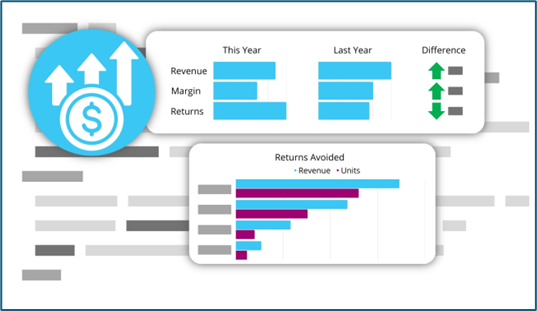
Newmine Chief Returns Officer
Product Development
Interpreting returns insights allows the product development teams to work with their vendor partners to optimize their line and address the specific reasons for returns. The Newmine solution helps to identify the root causes, allowing you to go through a discovery process and identify and prioritize the necessary corrective actions. These could range from a simple change to the website content or images to a more comprehensive partnership with vendors so the cut and product quality meet the customer's needs.
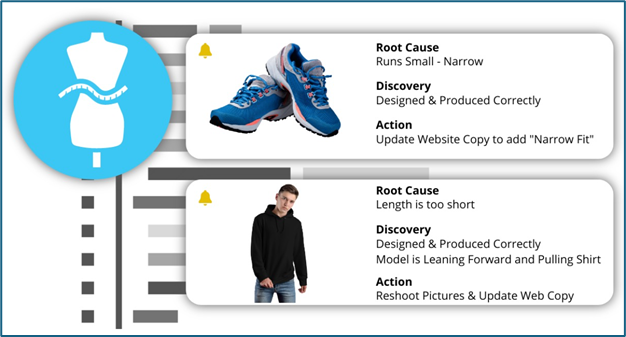
Newmine Chief Returns Officer
Assortment Planning
Considering the significant impact and cost associated with product returns, return rates must be part of the pre-season planning strategy conversations on which specific assortment categories to move forward, along with each item's related breadth and depth. Both online and in-store return rates provide compelling insights into which items retailers should invest in. Additionally, Newmine's return rate insights could be integrated into personalization strategies so merchant teams are better informed of each customer's size and style preferences.
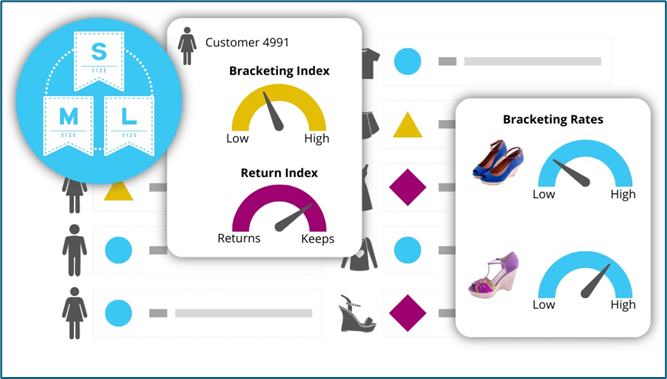
Newmine Chief Returns Officer
Return Channel Optimization (Stores, Third Party, and Vendor Management)
Despite the significant operating costs associated with product returns, there are capabilities and strategies retailers can leverage to mitigate the cost per item. According to a recent McKinsey survey, the difference in processing costs between the most and least expensive return channels is $5 to $6 on average.
Store Returns
There are many advantages to incentivizing customers to return online orders to retail stores via BORIS (buy online return in stores). Aside from the significant cost and time savings, it's a win-win for the retailer and customers. On average, processing returns at stores saves 18 days and improves the probability of reselling the item at full price. Additionally, the consumer can have a more immediate return experience and will most likely buy additional items at the store.
Return reduction strategies have proven to have environmental and sustainability benefits, helping to mitigate each item's overall carbon footprint.
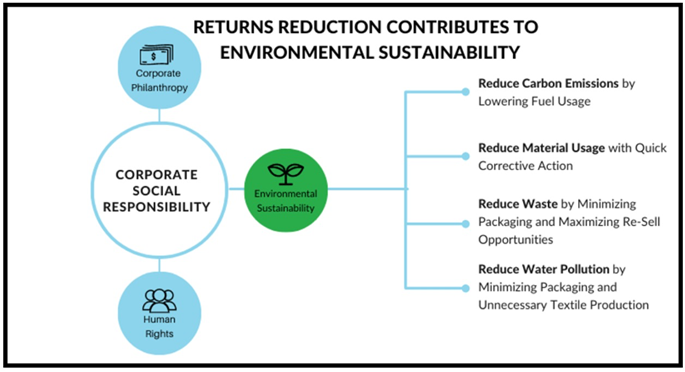
Returns Reduction Environmental Impact
Third-Party Drop-off Locations
Retailers can more efficiently and profitably partner with third-party drop-off points via a partnership model. In most scenarios, this offers a more efficient and profitable alternative to shipping returns to warehouses for processing. Expanding your network of returns locations provides retailers an opportunity to drive additional ecommerce conversion, improving customer experiences, leveraging your existing checkout flow, reducing stolen packages, and mitigating significant reverse logistics costs. This strategy prioritizes the customer and leads to greater loyalty and engagement.
Vendor Management
Through Newmine's consolidated intelligent capabilities, retailers can build a more enhanced collaborative operating model with their vendor partners. Providing the capabilities retailers need visibility to vendor/category performance will improve the go-forward ordering and product negotiations. KeepScore evaluates products, suppliers, and customers based on their likelihood of keeping or returning the merchandise.
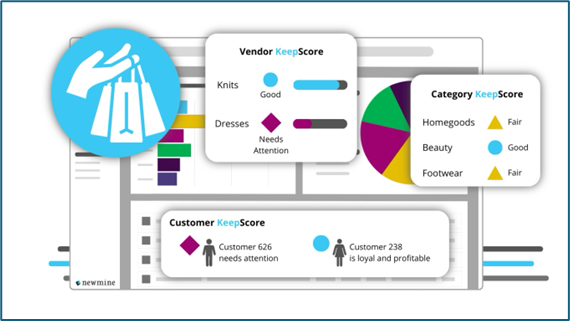
Newmine KeepScore
Via the KeepScore capabilities, retailers have an opportunity to continuously improve the product’s performance and quality by providing insights to drive:
- Category/SKU rationalization and expansion
- Comprehensive inbound flow planning (QA, Receiving, etc.)
- Vendor consolidation & expansion analysis
- RTV & chargeback allowance reviews
Starting the journey
In an industry focused on mitigating returns, the transformation mindset necessary to change the narrative of the reverse logistic process from a cost center into a profit driver requires an agile, customer-centric, product-centric collaboration model. There are trepidations and concerns that AI and GenAI are still in the hype cycle. However, in the race to unlock business value and drive profitability, Newmine and its AI-powered returns insight capabilities are a shining light in the emerging returns solutions space.
Artificial intelligence is now more seamlessly integrated within essential retail processes, providing insights to enhance revenues, reduce operational costs, and drive outstanding customer experiences. The returns process is no exception. Newmine is well-positioned to provide retailers with the tools and capabilities to keep up with digital-first customers and all the dynamic ways consumers shop and engage with retailers. This transformation can begin once retailers have clear visibility of the returns processes, a complete understanding of the unit economics of returns, and the ability to address the root causes of returns proactively.